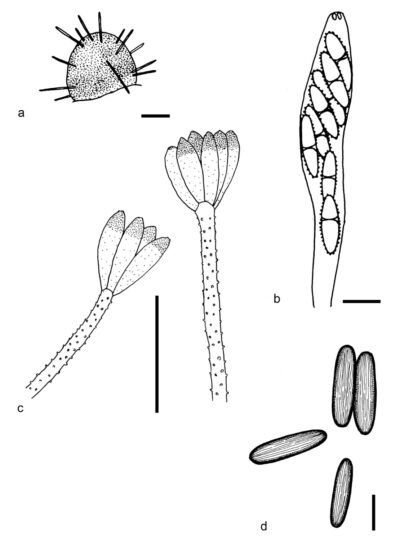Fungalpedia – Note 324, Striatibotrys
Striatibotrys L. Lombard & Crous
Citation when using this entry: Perera et al. 2024 (in prep.) – Fungalpedia, genera described in 2016.
Index Fungorum, Facesoffungi, MycoBank, GenBank, Fig. 1
Classification: Stachybotryaceae, Hypocreales, Hypocreomycetidae, Sordariomycetes, Pezizomycotina, Ascomycota, Fungi
Lombard et al. (2016) erected Striatibotrys to place a group of stachybotrys-like fungi that characterised by longitudinally striate conidia. They clustered distantly from Stachybotrys s. str. in the analysis of cmdA, ITS, rpb2, and tub2 (Lombard et al. 2016). Striatibotrys species produce astromatic, perithecial ascomata that are scattered, subglobose to obpyriform, orange and do not change colour in KOH. The ascomata have a rounded papillate apex with setae that protrude at the periderm surface, otherwise, they are completely submerged in the host tissue. Except for the ostiolar region, the ascomata are entirely encased in interwoven, thick-walled hyphae. Ascomatal setae erect, 1–2-septate, hyaline, thick-walled, and cylindrical with a rounded apex. The peridium consists of a single layer of textura globulosa. Paraphyses are branched and contain numerous oily droplets. Asci are 8-spored, clavate, and have a rounded to truncated apex with a refractive apical ring. Striatibotrys species possess ellipsoidal to fusiform ascospores, which are rounded at both ends, hyaline, and verrucose. The ascospores are orange in mass (Crous et al. 2013; Lombard et al. 2016). The asexual morph of the genus is characterized by macronematous, mononematous, and erect conidiophores that are solitary or in groups. They are 1–5-septate, unbranched or branched once, and hyaline to subhyaline, with an olivaceous brown apex. Conidiophores have thin and smooth walls with verrucose apices. Each conidiophore produced an apical cluster of three to six phialidic conidiogenous cells. The conidiogenous cells are clavate to subclavate, hyaline to pale olivaceous brown and have smooth to slightly verrucose walls and conspicuous collarettes. Striatibotrys are ellipsoidal to subcylindrical to fusiform, pale olivaceous to dark brown, aseptate, and longitudinally striate conidia. They possess rounded bases with apical hilum and smooth or longitudinally striated walls (Lombard et al. 2016). The genus accommodates nine species that occur in plant parts, plant debris, and soil (Lombard et al. 2016; Index Fungorum 2024).
Type species: Striatibotrys eucylindrosporus (D.W. Li) L. Lombard & Crous [as ‘eucylindrospora‘]
Other accepted species: Species Fungorum, search Striatibotrys
Figure 1 – Striatibotrys oleronensis (MH160412, holotype). a Ascoma on host substratum. b Ascus with ascospores. Scale bars: a = 100 μm, b = 10 μm. Striatibotrys eucylindrosporus c Conidiophores and conidiogenous cells. d Verrucose conidiophores. e Conidia. Scale bars: c, d = 20 μm, e = 5 μm. Redrawn from Li (2007) and Crous et al. (2013)
References
Entry by
Rekhani Hansika Perera, Center of Excellence in Fungal Research, Mae Fah Luang University, Chiang Rai, 57100, Thailand.
(Edited by Kevin D. Hyde, Samaneh Chaharmiri-Dokhaharani, & Achala R. Rathnayaka)
Published online 27 August 2024
